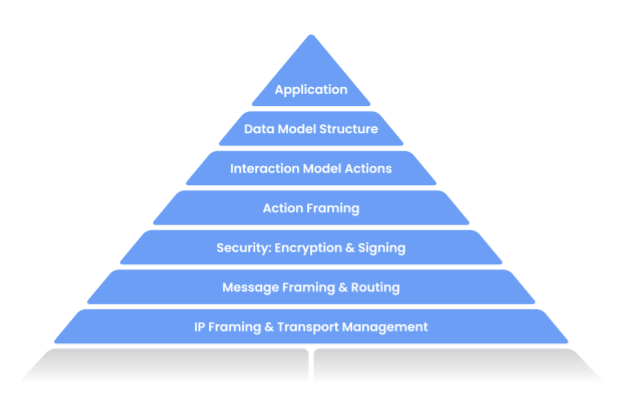What is “Matter”?
At the end of 2019 a group of CE companies got together to form an organization called “Matter” (formerly Connected Home Over IP or CHIP) that provides ‘a seal of approval that devices will work seamlessly together, today and tomorrow’. Under the guidance of the Connectivity Standards Alliance (formerly known as The Zigbee Alliance), the idea is to get competitors to work out open standards through collaboration and dialog, creating a library of protocols that enable ‘ a method for data sharing, interoperability, and security of messages over a network, where sensors, actuators and other devices can interoperate, regardless of underlying communication technology’, in other words the ability for any “Matter” certified product to communicate (with the permission of the user) with any other certified device.
While the architecture of the development model is overlaid on TCP, UDP, IPv6 and other protocols, the top-of the pyramid, aka the application layer, is the most important, and while unimportant to the outside world, is the focus of the collaboration between brands and represents those key areas where devices need commonality in order to work together. While they are all of importance, we single out three that we believe are key to understand the issues surrounding interoperability.
- Application – High order business logic of a device. For example, an application that is focused on lighting might contain logic to handle turning on/off the bulb as well as its color characteristics.
- Interaction Model - Represents a set of actions that can be performed on the devices to interact with it. For example, reading or writing attributes on a device would correspond to interactions with the devices.
- Security - An encoded action frame is then sent down to the Security Layer to encrypt and sign the payload to ensure that data is secured and authenticated by both sender and receiver of a packet.
Aside from the relatively high price of smart devices, we believe interoperability has been the biggest stumbling block to consumer acceptance or even understanding of smart devices. Yes, there are many applications that do not need to be ‘smart’, but then we could have said the same thing when cell phones were invented (“Who needs to speak to people when you are walking down the street or in your car?”), so we accept the fact that consumers get used to the convenience of smart devices over time is a given. However the frustration of having lots of smart devices that do not work together limits the ability of consumers to see the benefits of intelligently designed smart devices and that is what “Matter” is trying to solve.
That said, the CE space is one that must have momentum, and momentum in this case means participation by a large number of brands. The original founders of what is now “Matter” are Amazon, Apple, Comcast (CMCSA), and Google, but key CE brands like Samsung (005930.KS) and Huawei (pvt) are key players in the project, along with retailers like IKEA (pvt) and Kroger (KR), and semi suppliers such as Texas Instruments (TXN) and ST Micro (STM) and 150+ others. Now that the specifications have been completed (May 21), the certification will begin with new products throughout the remainder of the year and previously released products can become certified by updating firmware. As the standards are free (there is a fee to join the Alliance) there should be little resistance to join the alliance and as the public becomes aware of the potential benefits of “Matter” certified IoT products, momentum should build and help to legitimize smart devices a bit further.

 RSS Feed
RSS Feed